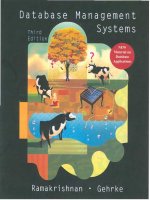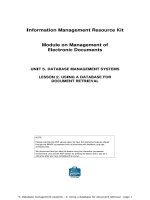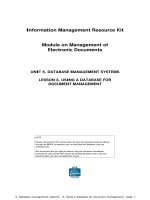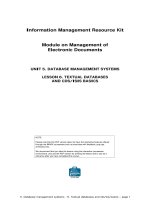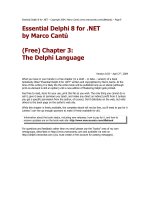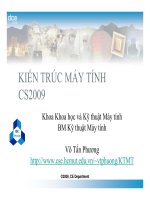Lecture Database management systems Chapter 3 The enhanced entity relationship (EER) model
Bạn đang xem bản rút gọn của tài liệu. Xem và tải ngay bản đầy đủ của tài liệu tại đây (1.61 MB, 39 trang )
Chapter 3
The Enhanced Entity - Relationship
(EER) Model
EER Model
The basic concepts of ER modeling are not
powerful enough for some complex
applications.
The Enhanced ER model is the extension of the
original ER model with new modeling
constructs.
EER Model
Include all modeling concepts of basic ER
Additional concepts:
◦ Subclasses/superclasses
◦ Specialization/generalization,
◦ Categories, attribute inheritance
Iƒt is used to model applications more completely
and accurately if needed
It includes some object-oriented concepts, such
as inheritance
Outline
Subclasses, Superclasses and Inheritance
Specialization and Generalization
Constrains and Characteristics
Union
Subclasses, Superclasses
In many cases an entity type has numerous
subgroupings of its entities that are meaningful
and need to be represented explicitly because of
their significance to the database application.
Ex: EMPLOYEE may be further grouped into:
◦ SECRETARY, ENGINEER, TECHNICIAN,
Based on the EMPLOYEE’s Job
◦ MANAGER
EMPLOYEEs who are managers
◦ SALARIED_EMPLOYEE, HOURLY_EMPLOYEE
Based on the EMPLOYEE’s method of pay
Subclasses, Superclasses
Subclasses, Superclasses
We call each of these subgroupings a subclass of the
EMPLOYEE entity type, and the EMPLOYEE entity
type is called the superclass for each of these
subclasses.
These are called superclass/subclass (as well as simply
class/subclass) relationships:
◦
◦
◦
◦
EMPLOYEE/SECRETARY
EMPLOYEE/TECHNICIAN
EMPLOYEE/MANAGER
…
These are also called IS-A relationships
◦ SECRETARY IS-A EMPLOYEE, TECHNICIAN IS-A
EMPLOYEE, ….
Subclasses, Superclasses
An Entity CANNOT exist in the database
merely by being a member of a subclass;
it must also be a member of the superclass
A member of the superclass can be
optionally included as a member of any
number of its subclasses
Subclasses, Superclasses
A salaried employee who is also an engineer
belongs to the two subclasses:
◦ ENGINEER, and
◦ SALARIED_EMPLOYEE
A salaried employee who is also an engineering
manager belongs to the three subclasses:
◦ MANAGER,
◦ ENGINEER, and
◦ SALARIED_EMPLOYEE
It is not necessary that every entity in a
superclass be a member of some subclass
Subclasses, Superclasses
Subclasses, Superclasses
An important concept associated with subclasses
is that of type inheritance
An entity that is member of a subclass inherits
◦ All attributes of the entity as a member of the
superclass
◦ All relationships of the entity as a member of the
superclass
Subclasses, Superclasses
Example:
◦ In the previous slide, SECRETARY (as well as
TECHNICIAN and ENGINEER) inherit the
attributes Name, SSN, …, from EMPLOYEE
◦ Every SECRETARY entity will have values
for the inherited attributes
◦ Every SECRETARY entity will also keep all
relationships
Specialization
Specialization is the process of defining a set of
subclasses of an entity type
The set of subclasses is based upon some
distinguishing characteristics of the entities in
the superclass
◦ Example: {SECRETARY, ENGINEER,
TECHNICIAN} is a specialization of EMPLOYEE
based upon job type.
Specialization
It may have several specializations of the same
superclass
Example: Another specialization of EMPLOYEE based
on method of pay is {SALARIED_EMPLOYEE,
HOURLY_EMPLOYEE}.
The subset symbol on each line connecting a
subclass to ϵ indicates the direction of the
superclass/subclass relationship
Specialization
Specialization
◦ Attributes of a subclass are called specific or
local attributes.
For example, the attribute TypingSpeed of
SECRETARY
◦ The subclass can also participate in specific
relationship types.
For example, a relationship BELONGS_TO of
HOURLY_EMPLOYEE
Specialization
There are two major reasons for including
class/subclass relationship and specialization in
a data model:
1. Certain attributes may apply to some but not
all entities of the superclass (secretary subclass
has local attribute Typing speed where engineer
has eng_type)
2. some relationship types may be participate in
only by entities that are members of the subclass
(Hourly_employees are related to Trade_nuion
via belongs_to)
Specialization
In summary, the specialization process
allows us to do the following:
◦ Define a set of subclass of an entity type
◦ Establish additional specific attributes with
each subclass
◦ Establish additional specific relationship types
between each subclass and other entity types
or other subclasses
Generalization
Generalization is the reverse of the
specialization process
Several classes with common features are
generalized into a superclass;
◦ original classes become its subclasses
Generalization
Example: CAR, TRUCK generalized into
VEHICLE;
◦ both CAR, TRUCK become subclasses of the
superclass VEHICLE.
◦ We can view {CAR, TRUCK} as a
specialization of VEHICLE
◦ Alternatively, we can view VEHICLE as a
generalization of CAR and TRUCK
Generalization
Constraints on Specialization and
Generalization
Two basic constraints can apply to a
specialization/generalization:
◦ Disjointness Constraint
◦ Completeness Constraint
Constraints on Specialization and
Generalization
Disjointness Constraint:
◦ An entity can be a member of at most one of
the subclasses of the specialization
◦ Specified by d in EER diagram
Displaying an attribute-defined
specialization in EER diagrams
Constraints on Specialization and
Generalization
Overlap:
◦
When the subclasses are not disjoint.
◦
The same entity may be a member of more
than one subclass of the specialization
◦
Specified by o in EER diagram

